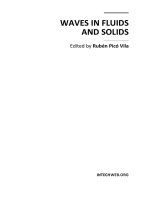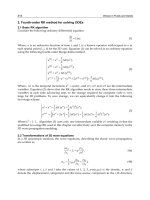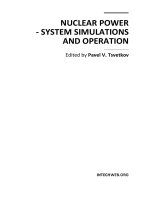Access: Acid-Base, Fluids, and Electrolytes - part 1 pdf
Bạn đang xem bản rút gọn của tài liệu. Xem và tải ngay bản đầy đủ của tài liệu tại đây (403.82 KB, 45 trang )
Lange Instant Access:
Acid-Base, Fluids,
and Electrolytes
Notice
Medicine is an ever-changing science. As new research and clinical
experience broaden our knowledge, changes in treatment and drug
therapy are required. The authors and the publisher of this work have
checked with sources believed to be reliable in their efforts to provide
information that is complete and generally in accord with the standards
accepted at the time of publication. However, in view of the possibility of
human error or changes in medical sciences, neither the authors nor the
publisher nor any other party who has been involved in the preparation or
publication of this work warrants that the information contained herein is
in every respect accurate or complete, and they disclaim all responsibility
for any errors or omissions or for the results obtained from use of the
information contained in this work. Readers are encouraged to confirm
the information contained herein with other sources. For example, and in
particular, readers are advised to check the product information sheet
included in the package of each drug they plan to administer to be certain
that the information contained in this work is accurate and that changes
have not been made in the recommended dose or in the contraindications
for administration. This recommendation is of particular importance in
connection with new or infrequently used drugs.
Lange Instant Access:
Acid-Base, Fluids,
and Electrolytes
Robert F. Reilly, Jr., MD
Fredric L. Coe Professor of Nephrolithiasis Research in Mineral Metabolism
Chief, Section of Nephrology
Veterans Affairs North Texas Health Care System
Professor of Medicine
Department of Medicine
The Charles and Jane Pak Center for Mineral Metabolism and Clinical Research
The University of Texas Southwestern Medical Center at Dallas
Dallas, Texas
Mark A. Perazella, MD, FACP
Associate Professor of Medicine
Director, Renal Fellowship Program
Director, Acute Dialysis Services
Section of Nephrology
Department of Medicine
Yale University School of Medicine
New Haven, Connecticut
New York Chicago San Francisco Lisbon London
Madrid Mexico City Milan New Delhi San Juan Seoul
Singapore Sydney Toronto
Copyright © 2007 by The McGraw-Hill Companies, Inc. All rights reserved.
Manufactured in the United States of America. Except as permitted under the
United States Copyright Act of 1976, no part of this publication may be repro-
duced or distributed in any form or by any means, or stored in a database or
retrieval system, without the prior written permission of the publisher.
0-07-150932-1
The material in this eBook also appears in the print version of this title: 0-07-148634-8.
All trademarks are trademarks of their respective owners. Rather than put a
trademark symbol after every occurrence of a trademarked name, we use names
in an editorial fashion only, and to the benefit of the trademark owner, with no
intention of infringement of the trademark. Where such designations appear in
this book, they have been printed with initial caps.
McGraw-Hill eBooks are available at special quantity discounts to use as pre-
miums and sales promotions, or for use in corporate training programs. For
more information, please contact George Hoare, Special Sales, at
or (212) 904-4069.
TERMS OF USE
This is a copyrighted work and The McGraw-Hill Companies, Inc. (“McGraw-
Hill”) and its licensors reserve all rights in and to the work. Use of this work is
subject to these terms. Except as permitted under the Copyright Act of 1976 and
the right to store and retrieve one copy of the work, you may not decompile, dis-
assemble, reverse engineer, reproduce, modify, create derivative works based
upon, transmit, distribute, disseminate, sell, publish or sublicense the work or
any part of it without McGraw-Hill’s prior consent. You may use the work for
your own noncommercial and personal use; any other use of the work is strict-
ly prohibited. Your right to use the work may be terminated if you fail to com-
ply with these terms.
THE WORK IS PROVIDED “AS IS.” McGRAW-HILL AND ITS LICEN-
SORS MAKE NO GUARANTEES OR WARRANTIES AS TO THE ACCU-
RACY, ADEQUACY OR COMPLETENESS OF OR RESULTS TO BE
OBTAINED FROM USING THE WORK, INCLUDING ANY INFORMA-
TION THAT CAN BE ACCESSED THROUGH THE WORK VIA
HYPERLINK OR OTHERWISE, AND EXPRESSLY DISCLAIM ANY WAR-
RANTY, EXPRESS OR IMPLIED, INCLUDING BUT NOT LIMITED TO
IMPLIED WARRANTIES OF MERCHANTABILITY OR FITNESS FOR A
PARTICULAR PURPOSE. McGraw-Hill and its licensors do not warrant or
guarantee that the functions contained in the work will meet your requirements
or that its operation will be uninterrupted or error free. Neither McGraw-Hill
nor its licensors shall be liable to you or anyone else for any inaccuracy, error
or omission, regardless of cause, in the work or for any damages resulting there-
from. McGraw-Hill has no responsibility for the content of any information
accessed through the work. Under no circumstances shall McGraw-Hill and/or
its licensors be liable for any indirect, incidental, special, punitive, consequen-
tial or similar damages that result from the use of or inability to use the work,
even if any of them has been advised of the possibility of such damages. This
limitation of liability shall apply to any claim or cause whatsoever whether such
claim or cause arises in contract, tort or otherwise.
DOI: 10.1036/0071486348
We hope you enjoy this
McGraw-Hill eBook! If
you’d like more information about this book,
its author, or related books and websites,
please click here.
Professional
Want to learn more?
v
To my wife Sheli, my parents Robert Sr. and Nancy, my son Rob,
and my brothers Steven and Fred, whose help and support are in-
valuable in both my life and career. Also to Marc Siegelaub and
Brad Thomas, who taught me the value of creative thinking, and
to Stephen Colbert who covers all the bases without acidity.
Robert F. Reilly, Jr.
To my parents Joseph and Santina, whose guidance made my
career in medicine possible, my brothers Joe and Scott, who are
a constant source of encouragement, my wife Donna, whose un-
selfish support allowed me to undertake this project, and my
sons Mark and Andrew, who bring boundless joy into my life.
Also to my good friends Mark Albini and John Magaldi, who
made the trek through medicine an interesting and unforgettable
experience.
Mark A. Perazella
This page intentionally left blank
vii
Contents
Contributors ix
Preface xi
Acknowledgments xii
1. BODY FLUID COMPARTMENTS AND 1
INTRAVENOUS FLUID REPLACEMENT
ROBERT F. REILLY, Jr., AND MARK A. PERAZELLA
2. DISORDERS OF SODIUM BALANCE 21
(EDEMA, HYPERTENSION OR HYPOTENSION)
ROBERT F. REILLY, Jr., AND MARK A. PERAZELLA
3. DISORDERS OF WATER BALANCE (HYPO- 55
AND HYPERNATREMIA)
ROBERT F. REILLY, Jr., AND MARK A. PERAZELLA
4. DIURETICS MARK A. PERAZELLA 103
5. DISORDERS OF K
+
BALANCE 131
(HYPO- AND HYPERKALEMIA)
MARK A. PERAZELLA
6. METABOLIC ACIDOSIS 171
DINKAR KAW AND JOSEPH I. SHAPIRO
7. METABOLIC ALKALOSIS 249
DINKAR KAW AND JOSEPH I. SHAPIRO
For more information about this title, click here
viii CONTENTS
8. RESPIRATORY AND MIXED ACID-BASE 287
DISTURBANCES
YOUNGSOOK YOON AND JOSEPH I. SHAPIRO
9. DISORDERS OF SERUM CALCIUM 307
ROBERT F. REILLY, Jr.
10. DISORDERS OF SERUM PHOSPHORUS 365
ROBERT F. REILLY, Jr.
11. DISORDERS OF SERUM MAGNESIUM 411
ROBERT F. REILLY, Jr.
12. APPENDIX 447
MARK A. PERAZELLA AND ROBERT F. REILLY, Jr.
Index 457
x CONTRIBUTORS
Joseph I. Shapiro, MD
Mercy Health Partners Education Professor
Chairman, Department of Medicine
Associate Dean for Business Development
Professor of Medicine and Pharmacology
The University of Toledo College of Medicine
Toledo, Ohio
Youngsook Yoon, MD
Associate Professor of Medicine
Division of Pulmonary and Critical Care Medicine
Department of Medicine
The University of Toledo College of Medicine
Toledo, Ohio
This page intentionally left blank
This page intentionally left blank
2 BODY FLUID COMPARTMENTS
1–11. Dextran as a Plasma Volume Expander 12
1–12. Albumin as a Plasma Volume Expander 12
1–13. Adverse Effects of Crystalloids and Colloids 13
General Principles 13
1–14. General Rules for Correction of the Fluid Deficit 13
1–15. Basics of Fluid Choice (Colloid vs. Crystalloid) 14
1–16. Electrolyte Content of Body Fluids 14
1–17. Insensible Losses and Maintenance 15
Requirements
Assessing Extracellular Fluid Volume 15
1–18. Assessment of ECF Volume 15
Fluid Resuscitation 16
1–19. Monitoring Fluid Resuscitation 16
Clinical Examples of Fluid Resuscitation 17
1–20. The Septic Patient 17
1–21. Crystalloids versus Colloids in the 18
Septic Patient
1–22. The Cardiac Surgery Patient 18
1–23. Albumin versus Hetastarch in CPB 19
BODY FLUID COMPARTMENTS 3
BODY FLUID COMPARTMENTS
TABLE 1–1: Body Fluid Compartments
An understanding of body fluid compartments is essential to
provide adequate patient care and for appropriate and
intelligent use of intravenous fluid replacement solutions
TBW constitutes 60% of lean body weight in men,
50% of lean body weight in women
• ICF compartment (two-thirds of TBW)
• ECF fluid compartment (one-third of TBW)
ECF compartment includes
• Intravascular space (25% of ECF)
• Interstitial space (75% of ECF)
Osmotic forces govern water distribution between
ICF and ECF (see Figures 1–1 and 1–2)
• Water flows from low osmolality to high osmolality
• Solute addition to the ECF raises osmolality
■
Water flows out of ICF until the gradient is gone
■
Water moves into and out of cells, resulting in cell
swelling or shrinking
Abbreviations: TBW, total body water; ECF, extracellular fluid;
ICF, intracellular fluid
4 BODY FLUID COMPARTMENTS
FIGURE 1–1: Body fluids are contained within the
intracellular fluid compartment and the extracellular fluid
compartment, which is composed of the interstitial and
intravascular fluid compartments
FIGURE 1–2: Factors Influencing Fluid Movement between
Various Compartments within the Body. Starling forces
govern water movement between intravascular and
interstitial spaces. Edema formation occurs from an
increase in capillary hydrostatic pressure and/or a
decrease in capillary oncotic pressure
BODY FLUID COMPARTMENTS 5
TABLE 1–2: Major Water-Retaining Solute
in Each Compartment
Extracellular fluid compartment—Na
+
salts
Intracellular fluid compartment—K
+
salts
Intravascular space—plasma proteins
6 BODY FLUID COMPARTMENTS
TABLE 1–3: Increased ECF Volume with Variable Serum
Na
؉
Concentration
Serum Na
+
concentration [Na
+
] is a ratio of the amounts of
Na
+
and water in the ECF
Three examples illustrate increased ECF volume where
serum Na
+
concentration is high, low, and normal
Addition of NaCl to the ECF
• Na
+
remains within the ECF
• Osmolality increases and water moves out of cells
• Equilibrium is characterized by relative hypernatremia
• ECF volume increases and ICF volume decreases
• Na
+
increases osmolality of both ECF and ICF
Addition of 1 L of water to the ECF
• Osmolality decreases, moving water into cells
• Equilibrium is characterized by relative hyponatremia
• Expansion of both ECF and ICF volumes occurs
• Only 80 mL remains in the intravascular space
Addition of 1 L of isotonic saline to the ECF
• Saline remains in the ECF (increases by 1L)
• Intravascular volume increases by 250 mL
• There is no change in osmolality
■
No shift of water between the ECF and ICF
■
Serum Na
+
concentration is unchanged
Abbreviations: ECF, extracellular fluid; ICF, intracellular fluid
BODY FLUID COMPARTMENTS 7
INTRAVENOUS SOLUTIONS
TABLE 1–4: Mechanism of Edema Formation
Increased Hydrostatic
Pressure
Decreased Capillary
Oncotic Pressure
Congestive heart failure Nephrotic syndrome
Cirrhosis of the liver Cirrhosis of the liver
Venous obstruction Malabsorption
TABLE 1–5: Critical Elements of IV Solution Use
IV solutions are used to expand intravascular and
extracellular fluid spaces
Assessment of the patient’s volume status
• Hypovolemia is common in hospitalized patients,
especially in critical care units
• Obvious fluid loss (hemorrhage or diarrhea)
• No obvious fluid loss (third spacing from vasodilation
with sepsis or anaphylaxis)
Knowledge of available solutions
• Colloid versus crystalloid
• Space of distribution
• Cost and potential adverse effects
Abbreviation: IV, intravenous
8 BODY FLUID COMPARTMENTS
TABLE 1–6: Replacement Options: Colloid versus
Crystalloid
Crystalloid solutions consist primarily of water and dextrose
Crystalloids rapidly leave the intravascular space and enter
the interstitial space
Colloid solutions consist of various osmotically
active agents
Colloids remain in the intravascular space longer
than crystalloids
TABLE 1–7: Replacement Fluid Options:
Crystalloid Solutions
Solution Osm GlucoseNa
؉
Cl
؊
Lactate
D5W 252 50 — — —
0.9% NS 308 — 154 154 —
0.45% NS 154 — 77 77 —
Ringer’s
lactate
272 — 130 109 28
Abbreviations: Osm, osmolality; D5W, 5% dextrose in water; NS,
normal saline
Units: Osm, mOsm/L; glucose, g/L; Na
+
, Cl
−
, and lactate, mEq/L
BODY FLUID COMPARTMENTS 9
TABLE 1–8: Replacement Fluids: Colloid Solution
Characteristics
Colloids increase osmotic pressure and remain in the
intravascular space for longer periods
Osmotic pressure is proportional to the number of particles
in solution
Colloids do not readily cross normal capillary walls
They promote fluid translocation from interstitial space to
intravascular space
Colloids include HES, dextran, and albumin
Colloids characteristics
• Monodisperse (albumin); MW is uniform
• Polydisperse (starches); MWs are in different ranges
Colloid MW determines the duration of colloidal effect
in intravascular space
Small MW colloids
• Large initial oncotic effect
• Rapid renal excretion
• Shorter duration of action
Abbreviations: HES, hydroxyethyl starch; MW, molecular weight
10 BODY FLUID COMPARTMENTS
TABLE 1–9: HES as a Plasma Volume Expander
HES is a glucose polymer derived from amylopectin
Hydroxyethyl groups are substituted for hydroxyl groups
on glucose
HES has a wide MW range (Polydisperse)
• Slower degradation and increased water solubility
• Degraded by circulating amylases and are insoluble at
neutral pH
One liter of HES expands the intravascular space
by 700–1000 mL
Duration of action depends on rates of elimination
and degradation
• Smaller MW species are rapidly excreted by kidney
• Degradation rate is determined by the following:
■
Degree of substitution (the percentage of glucose
molecules having a hydroxyethyl group substituted for
a hydroxyl group)
■
Location of substitution (positions C2, C3, and C6
of glucose)
Characteristics associated with a longer duration
of action
• Large MW
• High degree of substitution and a high C2/C6 ratio
BODY FLUID COMPARTMENTS 11
TABLE 1–9 (Continued)
Hetastarch (type of HES) characteristics
• Large MW (670 kDa)
• Slow elimination kinetics
• Increased risk of bleeding complications after cardiac and
neurosurgery due to these characteristics
• Increased risk of acute kidney injury in septic and
critically ill patients and in brain-dead kidney donors
• HES is contraindicated in the setting of kidney
dysfunction
Abbreviations: HES, hydroxyethyl starch; MW, molecular weight
TABLE 1–10: Characteristics of Albumin and Hetastarch
Albumin Hetastarch
Molecular weight 69,000 670,000
Made from Human sera Starch
Compound Protein Amylopectin
Preparations 25% and 5% 6%
12 BODY FLUID COMPARTMENTS
TABLE 1–11: Dextran as a Plasma Volume Expander
Dextrans are glucose polymers (MW ≈ 40–70 kDa) with
anticoagulant properties
Decrease risk of postoperative deep venous thrombosis
and pulmonary embolism
Decrease concentrations of von Willebrand factor
and factor VIII:c
Enhance fibrinolysis and protect plasmin from the inhibitory
effects of α
2
-antiplasmin
Increase blood loss after prostate and hip surgery
Increase acute kidney injury in acute ischemic stroke
Abbreviations: MW, molecular weight
TABLE 1–12: Albumin as a Plasma Volume Expander
Available in two different concentrations
• 5% solution: albumin (12.5 g) in 250 mL of normal saline
has a COP of 20 mmHg
• 25% solution: albumin (12.5 g) in 50 mL of normal saline
has a COP of 100 mmHg
One liter of 5% albumin expands the intravascular space by
500–1000 mL
Compared with crystalloid, albumin increases mortality risk
in certain patient groups, but the data are mixed
Mortality concerns and cost limit albumin use
Abbreviations: COP, colloid osmotic pressure
BODY FLUID COMPARTMENTS 13
GENERAL PRINCIPLES
TABLE 1–13: Adverse Effects of Crystalloids and Colloids
Colloids and crystalloids are not different in rates of
pulmonary edema, mortality, or length of hospital stay
Crystalloids
• Excessive expansion of interstitial space
• Predisposition to pulmonary edema
Colloids
• Potential to leak into the interstitial space when capillary
walls are damaged
TABLE 1–14: General Rules for Correction
of the Fluid Deficit
Physical examination and the clinical situation
determine the amount of Na
؉
and volume required
• Three to five liters in the patient with a history
of volume loss
• Five to seven liters in the patient with orthostatic
hypotension
• Seven to ten liters in the hypotensive septic patient









